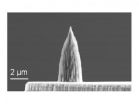(Press-News.org) There are plenty of effective anticancer agents around. The problem is that, very often, they cannot gain access to all the cells in solid tumors. A new gene delivery vehicle may provide a way of making tracks to the heart of the target.
Many types of tumor form a compact mass, like the phalanx formation of Greek antiquity. And although many drugs are known to be toxic to cancer cells, they are often unable to percolate into the inner recesses of the tumor. Upon intravenous administration, for instance, cytotoxic drugs may only be able to penetrate the outermost layers of a solid tumor. A team led by LMU pharmacologist Dr Manfred Ogris has now developed a new type of gene delivery vehicle, which is designed to open up a route through the vascular network that supplies the tumor so that drugs can reach their target.
Large tumors need a local blood supply for continued growth, and are capable of inducing the formation of new vessels. The resulting vasculature is more permeable than normal vessels, which should facilitate the delivery of cytotoxins. However, the lymphatic system does not work optimally in tumors, and back-pressure associated with the build-up of lymph limits the diffusion of drugs. As it happens, the cytokine Tumor Necrosis Factor α (TNFα), which can kill tumor cells directly, is able to increase blood vessel permeability as part of its pro-inflammatory function.
Shielding the organism from the drug
TNFα is already being used in combination with chemotherapeutic agents for the treatment of muscle tumors in arms and legs, but in this case, the local vasculature must be cut off surgically. "Unfortunately, therapeutically effective amounts of TNFα cannot be administered systemically, because this would lead to activation of, and damage to, all the vessels in the organism," says Ogris. "For this reason, it is not possible to use this approach on tumors in internal organs or against dispersed metastases."
A new strategy employing gene therapy could provide a solution to this problem. The idea is to deliver the gene for TNFα directly and specifically to the tumor cells. If this worked, the tumor cells themselves could produce and secrete the cytokine, ensuring that its local concentration becomes sufficiently high to permeabilize the blood vessels only in the immediate vicinity of the tumor. "We first designed a version of the TNFα gene that allows for the production of large amounts of the protein," Dr. Baowei Su, first author on the study, explains.
Shielding the drug from the organism
In collaboration with researchers at the Technische Universität München and the Helmholtz Center Munich, the LMU team constructed a form of the gene which, in contrast to the normal version, is unlikely to induce non-specific inflammation. The plasmid was then incorporated into special nanoparticles, which not only protect the DNA from inactivation during its journey through the bloodstream, but also allow it to be targeted to the tumor. Experiments carried out on cell cultures confirmed that tumor cells treated with these particles synthesize large amounts of TNFα.
Treatment with the loaded nanoparticles alone, however, had only a moderate effect on tumor cells, but when they were administered in combination with the DNA-intercalating drug doxorubicin, the impact on tumor cell growth was markedly enhanced. Under the trade name Doxil, doxorubicin, which inhibits DNA replication, is available in a liposome-encapsulated form. Incorporating the drug into liposomes of 100 nm in diameter reduces side-effects and increases its half-life in the circulation, making it more effective than unencapsulated formulations.
No evidence for drug resistance
When mice with neuroblastoma, or mice that had received a xenograft of a human liver tumor, were first exposed to nanoparticles carrying the TNFα gene and subsequently treated with Doxil the researchers observed, in real time, that the drug became concentrated in the tumor tissue. Indeed, in some cases, the combination was sufficient to bring tumor growth to a standstill, even in animals that had already undergone three cycles of treatment. This finding suggests that drug resistance, which often limits the efficacy of chemotherapy, does not develop in this context.
In addition to eliminating the primary tumor, a successful therapy must be able to kill metastatic tumors in other tissues. When the researchers looked at mice with neuroblastoma, or mice carrying implanted human colon tumors that had metastasized to the liver, they found that the new treatment strategy also significantly reduced the growth of metastases. "TNFα might also be useful in combination with other agents and other treatment regimens," says Ogris. "We now plan to optimize our gene delivery system, and hope that we can soon begin to plan preclinical tests of the new approach." (suwe)
###
Publication:
Systemic TNFα Gene Therapy Synergizes With Liposomal Doxorubicine in the Treatment of Metastatic Cancer
Baowei Su, Arzu Cengizeroglu, Katarina Farkasova, Joana R. Viola, Martina Anton, Joachim W. Ellwart, Rudolf Haase, Ernst Wagner, Manfred Ogris
Molecular Therapy, 2012
doi: 10.1038/mt.2012.229
Contact:
PD Dr Manfred Ogris
Phone: +49 89 / 2180 – 77842
Fax: +49 89 / 2180 – 77791
Email: manfred.ogris@cup.uni-muenchen.de
Web: www.cup.uni-muenchen.de/pb/aks/ewagner/m_ogris.htm END
Cancer therapy -- Nanokey opens tumors to attack
2012-11-14
ELSE PRESS RELEASES FROM THIS DATE:
Changing climate, not tourism, seems to be driving decline in chinstrap-penguin populations
2012-11-14
The breeding population of chinstrap penguins has declined significantly as temperatures have rapidly warmed on the Antarctic Peninsula, according to researchers funded in part by the National Science Foundation (NSF).
The study indicates that changing climatic conditions, rather than the impact of tourism, have had the greatest effect on the chinstrap population.
Ron Naveen, founder of a nonprofit science and conservation organization, Oceanites, Inc., of Chevy Chase, Md., documented the decline in a paper published in the journal Polar Biology. Naveen and coauthor ...
Preserving van Gogh's priceless masterpieces
2012-11-14
The chrome yellow pigment that renowned post-Impressionist artist Vincent van Gogh favored in priceless masterpieces like Sunflowers, the Yellow House and Wheatfield with Crows is especially sensitive to certain types of light and should be protected to prevent darkening. That's the conclusion of a series of studies in ACS' journal Analytical Chemistry, which could help preserve masterpieces by van Gogh and contemporaries like Gauguin, Cézanne and others.
Koen Janssens and colleagues explain that the chrome yellow pigment used by van Gogh and others in the 19th and 20th ...
Boosting the sensitivity of airport security screening
2012-11-14
Scientists are reporting a simple way to improve the sensitivity of the test often used to detect traces of explosives on the hands, carry-ons and other possessions of passengers at airport security screening stations. Their report appears in ACS' The Journal of Physical Chemistry C.
Yehuda Zeiri and colleagues explain that most tests for traces of explosives begin by rubbing a swab made from glass fiber, Teflon or cotton over the suspect material. Analysis of the swab in a detector — usually a device called an ion mobility spectrometer — alerts agents to any explosive ...
Ingredient in diarrhea medicine leads to sustainable new farm fertilizer
2012-11-14
The search for a sustainable slow-release fertilizer — a key to sustaining global food production at a time of burgeoning population growth — has led scientists to an ingredient used in some diarrhea medicines. They describe use of the substance, attapulgite, as a "carrier" for plant nutrients in a report in ACS' journal Industrial & Engineering Chemistry Research.
Boli Ni and colleagues explain that about half of the 150 million tons of fertilizer used worldwide every year goes to waste. That's because most fertilizers release nutrients too fast for the crops to use. ...
Nanometer-scale diamond tips improve nano-manufacturing
2012-11-14
One of the most promising innovations of nanotechnology has been the ability to perform rapid nanofabrication using nanometer-scale tips. The fabrication speed can be dramatically increased by using heat. High speed and high temperature have been known to degrade the tip… until now.
"Thermal processing is widely used in manufacturing," according to William King, the College of Engineering Bliss Professor at the University of Illinois at Urbana-Champaign. "We have been working to shrink thermal processing to the nanometer scale, where we can use a nanometer-scale heat ...
Life and death in a star-forming cloud
2012-11-14
The aftershock of a stellar explosion rippling through space is captured in this new view of supernova remnant W44, which combines far-infrared and X-ray data from ESA's Herschel and XMM-Newton space observatories.
W44, located around 10 000 light-years away within a forest of dense star-forming clouds in the constellation of Aquila, the Eagle, is one of the best examples of a supernova remnant interacting with its parent molecular cloud.
The product of a massive star that has already reached the end of its life and expelled its outer layers in a dramatic explosion, ...
You can be a star -- on science's stage
2012-11-14
The rapid growth in "citizen science" projects during the past decade is enabling more and more science enthusiasts, hobbyists, students and other ordinary people to participate in the excitement of real-world scientific research and help solve serious scientific mysteries. That's the topic of the cover story in Chemical & Engineering News (C&EN), the weekly newsmagazine of the American Chemical Society, the world's largest scientific society.
Deirdre Lockwood, C&EN contributing editor, traces the growth of citizen science from the Audubon Christmas Bird Count of 1900 ...
Television: Chronicle of a death foretold?
2012-11-14
Not only is TV not endangered, but it also has a unifying social impact on the nuclear family across the country. This is the main conclusion of a cross-Canada study—Are the Kids All Right?—on the television viewing habits of families with at least one child aged between 9 and 12 years. The study was conducted by a team of researchers led by André H. Caron, professor of communications at Université de Montréal and Director of the Centre for Youth and Media Studies (CYMS).
"Young Canadians today live in a different world than that experienced by previous generations. In ...
Could poor sleep contribute to symptoms of schizophrenia?
2012-11-14
Neuroscientists studying the link between poor sleep and schizophrenia have found that irregular sleep patterns and desynchronised brain activity during sleep could trigger some of the disease's symptoms. The findings, published in the journal Neuron, suggest that these prolonged disturbances might be a cause and not just a consequence of the disorder's debilitating effects.
The possible link between poor sleep and schizophrenia prompted the research team, led by scientists from the University of Bristol, the Lilly Centre for Cognitive Neuroscience and funded by the ...
World's largest respiratory genetics study launches on World COPD Day
2012-11-14
Researchers from the Universities of Nottingham and Leicester are leading the largest ever study of the genetics relating to lung disease.
The project will investigate what determines an individual's lung health and why smoking harms the lungs of some people more than others and will use health information held by UK Biobank, a major national resource holding health information from half a million volunteers.
The study, funded by the Medical Research Council (MRC) and also involving scientists at St George's, University of London, is aiming to shed light on why some ...


